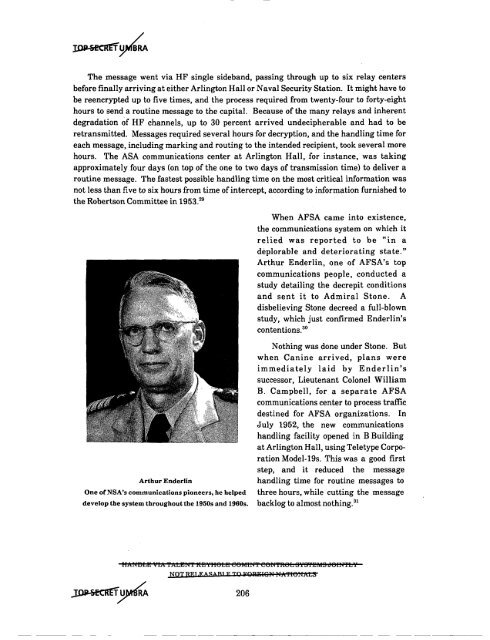American Cryptology during the Cold War - The Black Vault
American Cryptology during the Cold War - The Black Vault
American Cryptology during the Cold War - The Black Vault
You also want an ePaper? Increase the reach of your titles
YUMPU automatically turns print PDFs into web optimized ePapers that Google loves.
<strong>The</strong> message went via HF single sideband, passing through up to six relay centers<br />
before finally arriving at ei<strong>the</strong>r Arlington Hall or Naval Security Station. It might have to<br />
be reencrypted up to five times, and <strong>the</strong> process required from twenty-four to forty-eight<br />
hours to send a routine message to <strong>the</strong> capital. Because of <strong>the</strong> many relays and inherent<br />
degradation of HF channels, up to 30 percent arrived undecipherable and had to be<br />
retransmitted. Messages required several hours for decryption, and <strong>the</strong> handling time for<br />
each message, including marking and routing to <strong>the</strong> intended recipient, took several more<br />
hours. <strong>The</strong> ASA communications center at Arlington Hall, for instance, was taking<br />
approximately fOUf days (on top of <strong>the</strong> one to two days of transmission time) to deliver a<br />
routine message. <strong>The</strong> fastest possible handling time on <strong>the</strong> most critical information was<br />
not less than five to six hours from time ofintercept, according to information furnished to<br />
<strong>the</strong> Robertson Committee in 1953. 29<br />
Arthur Enderlin<br />
One ofNSA's communications pioneers, he helped<br />
When AFSA came into existence,<br />
<strong>the</strong> communications system on which it<br />
relied was reported to be "in a<br />
deplorable and deteriorating state."<br />
Arthur Enderlin, one of AFSA's top<br />
communications people, conducted a<br />
study detailing <strong>the</strong> decrepit conditions<br />
and sent it to Admiral Stone. A<br />
disbelieving Stone decreed a full-blown<br />
study, which just confirmed Enderlin's<br />
contentions. 30<br />
Nothing was done under Stone. But<br />
when Canine arrived, plans were<br />
immediately laid by Enderlin's<br />
successor, Lieutenant Colonel William<br />
B. Campbell, for a separate AFSA<br />
communications center to process traffic<br />
destined for AFSA organizations. In<br />
July 1952, <strong>the</strong> new communications<br />
handling facility opened in B Building<br />
at Arlington Hall, using Teletype Corporation<br />
Model-19s. This was a good first<br />
step, and it reduced <strong>the</strong> message<br />
handling time for routine messages to<br />
three hours, while cutting <strong>the</strong> message<br />
develop <strong>the</strong> system throughout <strong>the</strong> 19508 and 1960s. backlog to almost nothing. 31<br />
IIIdof5LI!J • fA 'fALl!Jlof'f f~1!J i II6LI!J e6MI!of'f e6!of'fft6L S-YS'fI!JMS d'6Hof'fJ:S<br />
NOT REJ.EASABJ E TO i'QRiJIElN ?iA't'16Iof*L~<br />
206<br />
-- -_. -_._------------- - _ .. ---------
















